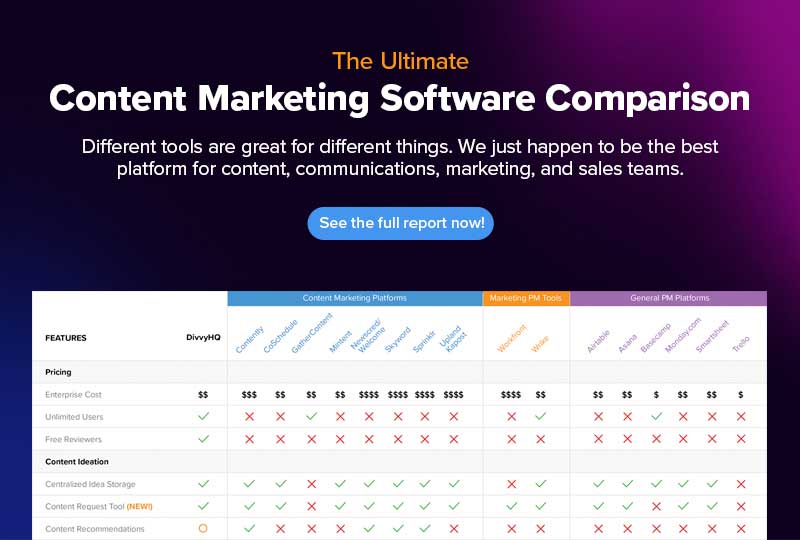DivvyHQ vs. Trello: Comparing Content Marketing Platforms
Enterprise content marketing teams rely on technology to streamline operations. With the right platform, your team can stay productive and organized. But finding that ideal platform is harder than it sounds, especially when it comes to content marketing platforms. There are so many tools out there that claim to be the perfect fit for content teams, but end up being too small/simple, or too complex and clunky. In this post, we’re focusing in on the comparison between DivvyHQ vs. Trello.
We’ll define how each solution stacks up in several categories, including:
- Pricing
- Content ideation features
- Content and editorial planning capabilities
- Workflow and collaboration offerings
- Content production and asset storage features
- Publishing functions and integrations
- Content and team performance analytics
- Service and support
- Setup and implementation requirements
- Security
- Other factors
Comparison Methodology
How did we complete the comparison of DivvyHQ vs. Trello? Our staff dug into various resources, including company websites, free trials, knowledge bases, review sites, and additional sources. The full report and methodology is available here: Content Marketing Platforms: DivvyHQ vs. the Alternatives.
In deciding what features to spotlight, we included the tools and features that content, marketing and communications teams need to do their job. Consider the criteria to be similar to those used by analyst firms Gartner and Forrester for the annual reports they publish on content marketing platforms (CMPs).
While we did our best to gather all available information, but we certainly may have missed something. Not all platforms provide all details to the public.
If you’re a staff member of Trello, and you see something we got wrong, leave us a comment. We’ll fix it.
Now that we’ve defined the how, let’s get started.
Enterprise Pricing
Since the cost of a solution typically impacts your choice, it’s important to understand how different platforms approach the market at various pricing levels and with different pricing models.
That said, Trello is by far the cheapest solution in our competitive analysis. Why is that? Well, there are a few reasons I would pose. Firstly, Trello is a very simple project management (PM) tool that can be used to manage virtually any kind of task in a Kanban board style (see example below). Secondly, since anyone can use it for anything, they’ve deployed a freemium model (free to start, pay for more features later) to attract the masses. The main issue here is that you really don’t get any content-centric functionality (more on that below) and ultimately, you get what you pay for.
Outside of the freemium scenario, both Divvy and Trello have higher-level plans that offer more features at a per-seat cost. The more users you have, the more expensive it can get. DivvyHQ, however, has unlimited user plans that cap the cost for larger teams. Also, DivvyHQ doesn’t charge for read-only viewers (a.k.a. Reviewers).
Content Ideation
Enterprise content teams need content ideation tools. DivvyHQ delivers on this with a central repository for content ideas that can easily be turned into projects and scheduled on your content calendar with a simple drag and drop. We also recently introduced our Content Request Tool, that gives enterprise content teams everything they need to formalize their content request intake process.
Trello doesn’t really have any dedicated features for content ideation out of the box, but as is common for Kanban style planning, one of the columns can be designated as an ideas area or backlog. All other features would require third-party tools and integrations.
Content and Editorial Planning Capabilities
Planning is an essential element in content marketing. Implementing the right planning tool is key within busy organizations, especially when you consider the benefits that automated workflows and a robust content calendar can bring. DivvyHQ and Trello both have dynamic content calendars and offer these content calendar features:
- Drag and drop rescheduling
- Project and task prioritization
- Duplication of projects
- Multiple views (list, calendar, etc.)
However, enterprise teams need more out of their content calendar. Divvy alone offers more, including:
- Flexible architecture for different calendars for different business units, teams, brands, locations, or other segments
- Robust filtering
- Shareable views for non-users
- Color-coding
- Content strategy metadata management for filtering and reporting of the data (Users find this useful to understand what groups are receiving what content.)
Both products have campaign planning and management.
Workflow and Collaboration Offerings
Technology can play a big role in helping teams standardize and automate content workflows and facilitate collaboration across teams. But different platforms vary widely in their functional offerings in this category.
For example, Trello’s native Kanban format is essentially a single, simple workflow that can become the standard process that all projects work through. In many general cases, this may be exactly what a project manager needs. But then there’s the content planning, producing, reviewing, approving, publishing, optimizing, promoting and measuring process. It is not simple. And it gets exponentially harder as the volume of content and the number of people involved increases.
Image: Wikipedia
So, let’s start with the workflow and collaboration tools that both software products provide:
- Task management
- Custom workflow creation
- Real-time browser notifications
- Commenting with @mentions in content to tag users
Key differences lie in the architectural approach that the two platforms take. A single Trello board can be customized with a specific workflow. Similarly in Divvy, a single content calendar (Ex: your blog calendar) can be customized with a specific content workflow that manages all the steps required to get a blog post written, reviewed, approved, optimized, published and promoted.
DivvyHQ takes this several steps further though with automated workflow scheduling, notifications, and reminders.
Content Production and Asset Storage Features
For this category of functionality, the differences between platforms are much more obvious. Considering what content professionals are doing day in and day out, having some solid content production tools and integrated mechanisms for storing and retrieving content assets (images, videos, etc.) is crucial. Since DivvyHQ was built specifically for content marketers, it has some unique features that Trello does not:
- HTML content editor
- Social post editor
- Content archive and auditing
- Asset library
- Change tracking and version history
Really the only commonality between the two here are the capacity for unlimited file storage.
Publishing Functions and Integrations
Integrations make workflows easier and improve productivity. Here are the current integration partners for each platform.
DivvyHQ Integrations
- WordPress
- Zapier
- Google Drive
- Dropbox
- Microsoft OneDrive
- SharePoint
- Box
- EPiServer
- Kentico
- Microsoft Outlook calendar
- Google calendar
- iCal
Trello Integrations
- Zapier
- Google Drive
- Dropbox
- Microsoft OneDrive
- Box
- Kentico
- Microsoft Outlook calendar
- Google calendar
- iCal
Both platforms have an open API that can be used an many ways.
Content and Team Performance Analytics
Is your content achieving the objectives that you’ve defined? Is it aligned with your overall content strategy? What about your team performance? Is your team hitting deadlines? Are you producing more content this year vs. last year?
Having a content analytics platform to track and report on these types of data points can be HUGE in helping you determine the performance of your content and team. However, most project management platforms (Trello included) lack much of this reporting functionality.
Not only does DivvyHQ provide all this, it simplifies the reporting process by aggregating data from over 100 sources into a single analytics hub. In addition, Divvy provides basic time tracking, reports for on-time completion, and strategic alignment insights.
Trello simply doesn’t have any of that.
Service and Support
Enterprise teams need the assurance of great service and support after deployment. bDivvyHQ uses a customer-centric approach to service and support. Customers receive live onboarding and a dedicated support team. We’ll also evaluate your content strategy, delivering recommendations and an analytics assessment. Users can also enjoy on-demand online support chat.
With Trello, you’ll only receive online support chat.
Setup and Implementation Ease
Easy technology makes every user happy. DivvyHQ and Trello both do this well. It takes less than four hours to configure each, and you don’t need any custom coding.
Security
Security matters as well in deciding what software to deploy. DivvyHQ and Trello prioritize this, offering:
- Robust user permissions and rules
- SSO (single sign-on)
- Two-factor authentication
Everything Else
Other noteworthy features that both platforms have are mobile-friendliness and no administrator/full-time employee requirements to manage.
DivvyHQ vs. Trello: What’s Right for You?
Bottomline, Trello is an excellent general PM tool for smaller teams who may have a lot of general projects to manage. But for content teams, it does lack many features that are critical to managing complex content processes. Our application design and functionality are tailored specifically for content marketing, period. If you’d like to experience the difference, try it out for free today.



